This article deals with the first month of a baby's life and how to accustom him to the regime.
Contents
- Baby mode in the first month
- Feeding the baby of the first month of life
- Drinking mode of the newborn
- Baby chair of the first month of life
- Bathing the baby in the first month of life
- Child care in the first month of life
- Sleeping the baby in the first month of life
- How to teach the newbornto the regime?
- How to change the mode of the baby?
- Video: Newborn Day Mode in 1 Month
With the advent of the baby, chaos can form in the family - parents can start experiencing time deficit not only against each other, but even on themselves. To avoid this, from the first days of life, the baby should pay attention to his regime of the day, for the establishment of which will take some time.
Newborn mode in the first month

In the first two weeks a child sleeps about 20 hours a day and eats - it's his main responsibilities. As the child grows up, starting from 3-4 weeks, he begins to watch more and more, to study the world around him.
It is very important even before the birth of a child to determine the issue of feeding the baby - according to the regime( every 3 hours) or on demand. It is necessary to deal with this issue in detail and choose the best option for yourself.
In addition to feeding and sleeping, the child's regime includes:
- Hygienic procedures
- Walking
- Games
- Rituals preceding all of the above items
IMPORTANT: The correctly installed mode contributes to the physical and mental development of the baby. It is proved that children with an established regime have a good appetite, sleep well, are less anxious, at the same time are active and vigorous.
It should also be remembered that the establishment of a child's regime will help him to better navigate the change of day and night. And this is important for newly-made parents - they will have the opportunity to relax, restore strength, and spare time for themselves and others.

Feeding the baby of the first month of life
To determine the mode of the newborn it is necessary to determine how the baby will be fed:
- By the hour - every three hours
- At the request of
Let us consider them in more detail.

The system of feeding by the clock became actual even in Soviet times. It was due to the fact that having given birth, a woman needed to go to work. Due to the fact that it was not possible to adjust the working schedule for feeding the child, it was necessary to do the opposite.
Thus the child ate in the afternoon once every three hours, at night there was a break at six o'clock. The feeding lasted no more than 20 minutes.
This feeding system has its advantages:
- It's easier to set the child's mode
- Mom can easily plan its day by spending time with herself and her husband
- Getting used to the regime, the baby will become calmer, will not bother her at night
There are also minuses:
- At the beginningthe child will be difficult to get used to such a schedule - the newborn's need for feeding in the first month of life is usually once every 1.5-2 hours. Parents will have to work hard to distract the baby
- . It's not always enough for 20 minutes for the baby to eat. The intensity of sucking can be different. This can lead to malnutrition, and as a result, the baby may not gain weight
- Applying the baby to the breast every three hours and incomplete emptying of the chest can lead to lactostasis and mastitis
- Causes from the previous subparagraph may also lead to extinction of lactation. With insufficient stimulation of the breast, milk is produced less and less. This is due to the fact that Soviet women did not breast-feed their children for long, usually up to six months.
- This mode of feeding is difficult for the child to endure from a psychological point of view - a long absence of intimacy with the mother
Feeding by the clock was considered correct for a very long time. It should be noted that some experts still consider this feeding system to be the most optimal.
Feeding on demand.

IMPORTANT: Feeding the baby on demand is considered a natural feeding - historically developed. This approach to feeding the baby appeared with the first person.
The system of feeding a child on demand is simple - a child eats when he wants it. He receives the breast after the first cry or crying and enjoys it as much as he likes, without time limitation.
Breastfeeding breasts on demand:
- Mom should always be near the baby. There is no possibility to absent, becausethe child at any moment may require a breast
- Due to the fact that the child is not limited in time, he can permanently bind his mother to himself. It should be remembered that among the kids there are often lovers of sleep on the mother's breast
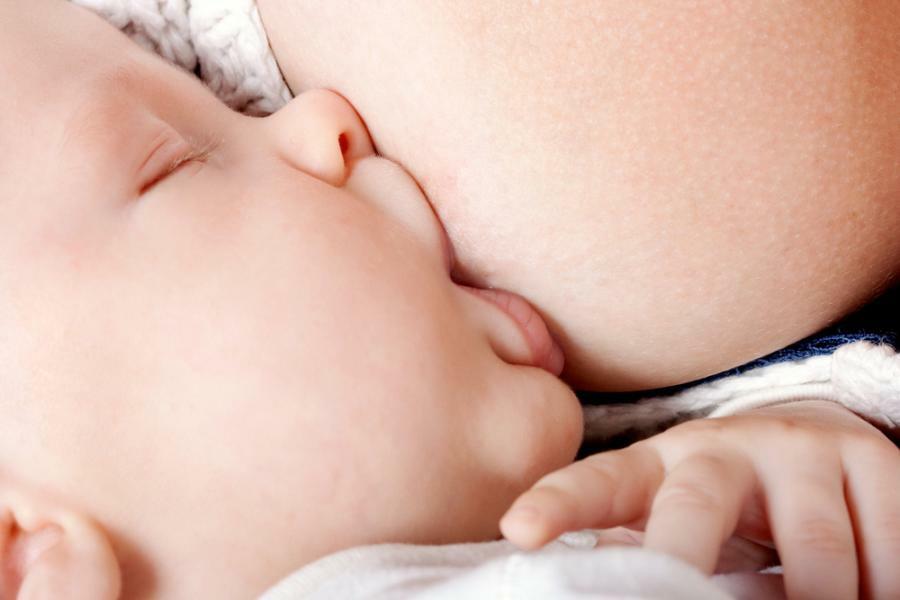
- The child can often wake up at night, demanding the chest
- During breastfeeding, the mother is so used to this close relationship with the baby that it is very difficult to stop breastfeeding. It should be noted that breastfeeding on demand usually lasts a long period of time, more often than the year of the child
And the benefits of feeding the baby on demand are as follows:
- It's hard to overestimate the benefits of breast milk, especially when the child gets it as much as he wants
- Babies get sick less often, Minimize problems with the gastrointestinal tract
- Breast problems in the mother are minimized - permanent breast emptying occurs
- Lactation is quickly adjusted, occurs ontoyannaya milk production, so the mom can long time to breastfeed her baby
- Frequent breastfeeding there is a possibility the child easily do without pacifiers
IMPORTANT: It is proved that the child is breast-fed more calm.

As for children on artificial feeding, the main task of parents is to choose the right baby food, and also its quantity. It is necessary to observe the necessary diet.
It takes more time to assimilate the milk formula than to assimilate breast milk. Thus it is necessary to feed the child once every three hours. The total number of feedings is about 8 times a day.
IMPORTANT: Baby food manufacturers describe in detail the way of preparing the mixture on the packaging. Do not neglect this information.
The volume of the mixture in the first ten days of the baby's life should be calculated by the formula:
- The number of days lived is multiplied by 10, ml
Beginning from the second week until the end of the first month, the mixture volume should be calculated as follows:
- Weight of the child divided by 5, ml
- received volumedivided by the number of feedings per day( approximately 6-7 times), ml
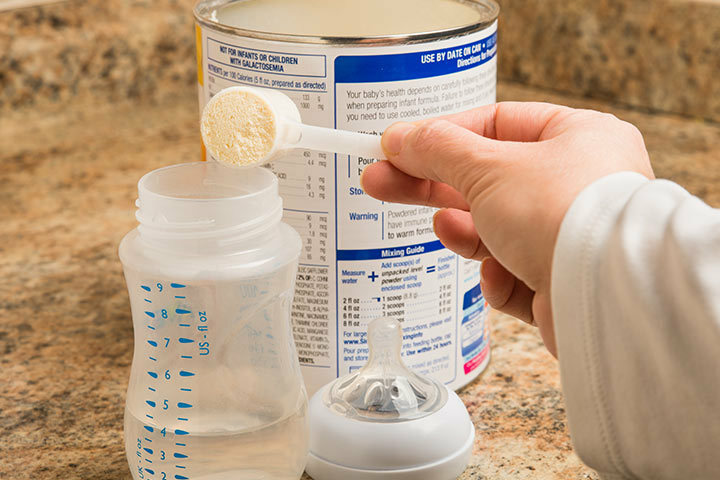
Drinking mode of a newborn
To give water to a newborn or not depends on the type of feeding of the baby - thoracic or artificial, and also on his state of health.
With regard to breastfeeding, the opinions of specialists differ:
- Some believe that it is impossible to finish dosing
- Others believe that a newborn should be offered water, but do not insist. He himself decides whether he needs water
- Still others think it is necessary to give water to a newborn
The World Health Organization believes that breast milk is both food and drink, which is 90 percent water. Therefore, it is not necessary to milk the baby for up to six months.
However, there are cases when a child should be given water:
- If necessary, administer the medicine to the baby. It is better to dilute medicinal preparations in water, rather than milk
- In case the child refuses milk
- in case of dehydration of the baby's body. Signals of dehydration can be a fused fontanel and darkened color of urine. More often such cases are observed in summer in hot weather
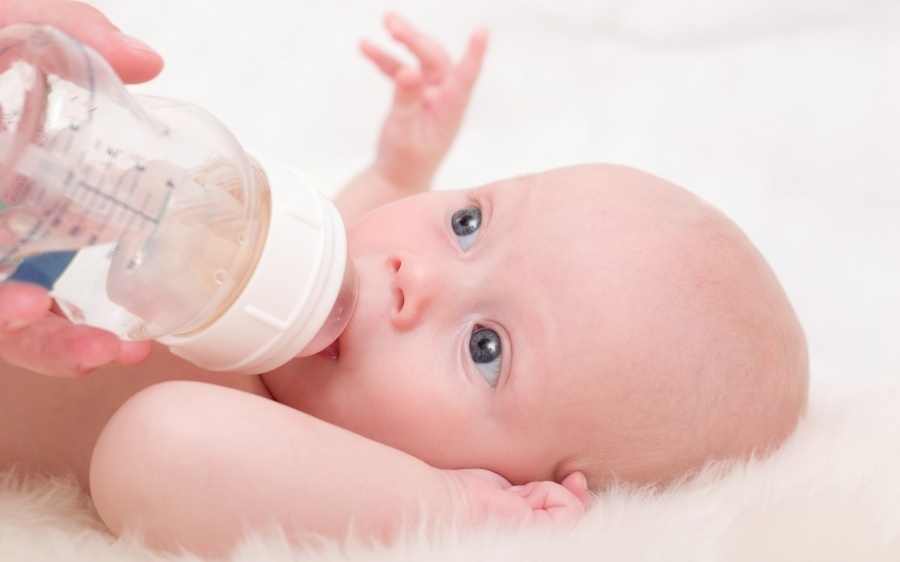
IMPORTANT: If in the room where the baby is hot and dry, more often apply it to the chest. Ventilate and moisten the room.
If you decide to give your baby water, then remember that you should not give more than 60 ml per day and more than 20 ml at a time. Otherwise, a newborn can have a feeling of fullness, thereby, he will receive less nutrients with breast milk.
In order for the child not to give up the mother's breast, water should not be given from the bottle, but with:
- Teaspoon
- Syringe
It is very important to choose the right water for the newborn. It is best to use special children's water, bought in a pharmacy or purified bottled water.
As for the drinking regimen of children on artificial feeding, all specialists agree that such babies must be dosed with water. Drinking should be offered between feedings.
IMPORTANT: Do not insist that if the baby does not want to drink, it may be enough for him and the water that you use to make the mixture.
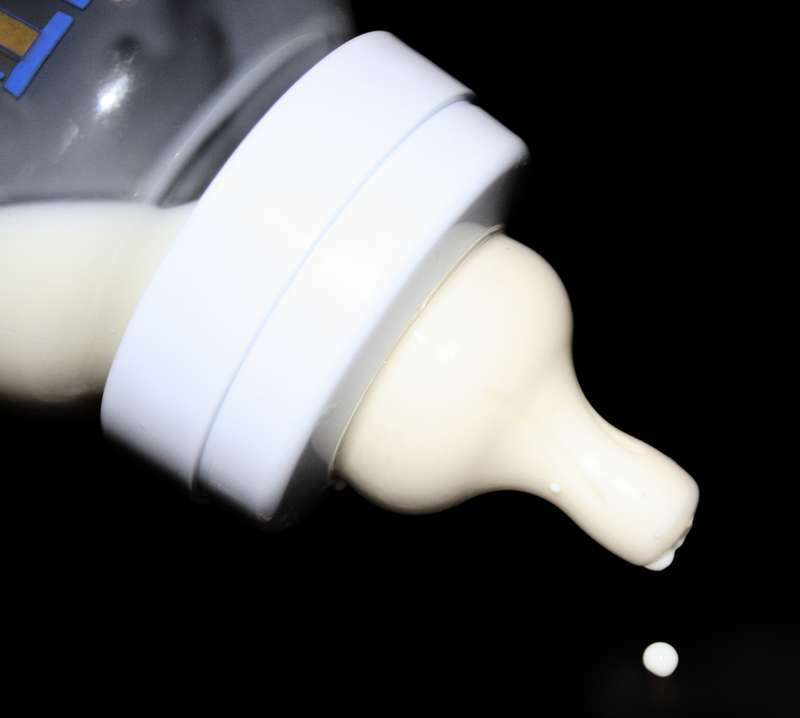
Child's chair of the first month of life
In the first day or two the baby has a dark green, even a black chair - meconium. Meconium - the first-born stool - everything that has gathered in a small organism for the time being in my mother's tummy is released. Meconium has a tarry consistency.
Usually, by the third or fourth day of a child's life, his stool gets a greyish-green color and a more liquid consistency. This chair is observed until the end of the first week of life crumbs.

Then the chair of the child is restored. Ideally, it should have a mushy consistency and a yellow-brown-orange color. Possible white sprinkles and an admixture of mucus. Acidic smell, not sharp.
The frequency of stool in infants who are breastfed can vary from four to twelve times a day, most importantly, while the baby gaining weight. The frequency of the stool depends directly on the frequency of feeding.
IMPORTANT: Sometimes a toddler on breastfeeding has a stool frequency once every two to three days. Experts say that this is also normal - breast milk is well absorbed.
With artificial feeding, the stool frequency is less frequent, about four times a day. Consistency is more dense. The color can be from light yellow to brown.
IMPORTANT: In the first month of life, a child's stool is an indicator of his health.

Be sure to watch for any changes in the stool - for its color, smell, consistency. Pay attention to the behavior of the crumbs. If the color of the stool becomes green, there will be a sharp smell, lumps, foam, and the baby will be whimsical, be sure to ask your doctor for help.
IMPORTANT: Parents should not self-medicate. Sometimes the use of various decoctions, much less medicines, can only harm your baby. Treatment should appoint a specialist, after a comprehensive assessment of the health of the baby.
Bathing a baby in the first month of life
Bathing a newborn should be a daily ritual. This hygienic procedure pursues and developing goals - the muscles of the crumb become stronger. Daily bathing helps to strengthen the baby.
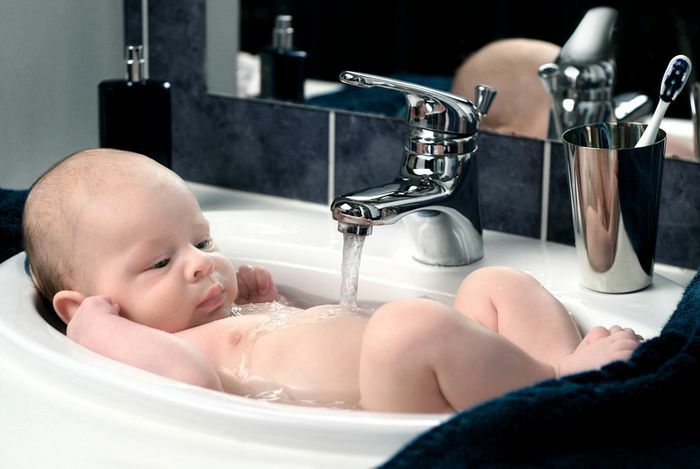
- It is not necessary to bathe the baby in the first day after discharge from the hospital - let him get used to the new situation. On the second day, the baby needs to bathe
- . To bathe the crumb is necessary in a separate bath. Boil water is not necessary, tk. Boiling aims to kill all microbes in the water. But, it should be remembered that as soon as the water starts to cool down, microorganisms will start multiplying again. Therefore, it will be enough just to add a weak solution of potassium permanganate
- to the baby's bath. It is advisable to grow it in a separate glass dish. Then strain the solution through 5-6 layers of gauze. This will help to avoid the penetration of undissolved potassium permanganate crystals into the bath - and, as a result, avoid burns of the delicate skin of the baby
- . To bathe the baby in a weak solution of potassium permanganate until the umbilical wound of the
is healed. In the future, the following herbs can be used for bathing the newborn:
- Chamomile. Chamomile possesses the anti-inflammatory, soothing effect of
- Skulls. The sequence promotes skin regeneration, promotes the removal of inflammation and the destruction of microorganisms
- Oak bark. Oak bark helps to cope with diaper rash and chalk
IMPORTANT: The addition of herbal decoctions to the baby bath can cause a severe allergic reaction in the newborn. It is advisable to exclude their use if any member of the family has a tendency to allergies.
The temperature of the water for bathing the newborn should be 37 ° C.As early as the third week, it is possible to begin tempering the baby - once every two weeks, lower the water temperature by 0.5 ° C, gradually bringing it to 34 ° C.
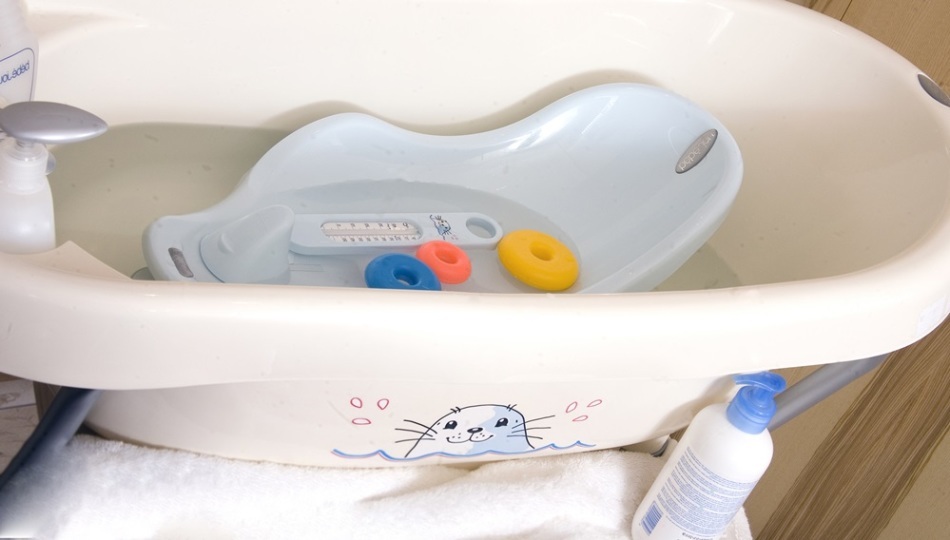
- Before you start bathing the baby, make sure that everything is ready for you - baby baths, a container with clean water, a soft towel or diaper
- When choosing a bathing product, give preference to simpler, natural products that do not contain dyes, perfumes,sulfates. Avoid means that contain sodium lauryl sulfate - this is the most stringent chemical composition used in cosmetics, leading to a strong allergy.
- A container with clean water is necessary in order to rinse the baby after bathing. The temperature of this water is one degree below the water contained in the
- bath. Bathing should be done between the feedings, but not earlier than one hour after the last meal. In this case, the baby should not be too hungry, becausebathing should bring him pleasure. Due to hunger, the baby can cry strongly
- It is necessary to slowly lower the child into the water. Starting from the legs, gradually immerse the whole body, while supporting the baby's head. At first, 5 minutes will suffice for swimming.
IMPORTANT: At first the baby may be afraid to swim naked, for this you should use the way of bathing in the diaper.

It is not necessary to use for bathing a newborn bast. The skin of the baby is so tender that it is possible to apply micro-trauma.
The crumb should be washed with a hand or with a soft cloth. Pay special attention to the natural folds on the skin of the baby, as well as to the axillary hollows. The head should be washed at the end of the bath. Soap, shampoo, foam should not be used more than twice a week.
After bathing:
- Baby's skin should be dry with a diaper or a soft towel
- All wrinkles on the skin should be treated with powder, baby cream or oil.
- Treat umbilical wound first with hydrogen peroxide and then with greenery.
IMPORTANT: The child should be bathed at the same time. This will contribute to the early establishment of the regime of the baby.

Child care in the first month of life
For details on caring for a child in the first month of life, read the Rules for Daily Care for the Newborn. Step-by-step hygienic care
Sleep of the baby in the first month of life
Sleep on a par with eating is an important indicator of the health of the baby. In the first two weeks of a child's life, sleep should be about 20 hours a day. As you grow older, starting from the third week, the dream will gradually decrease, and the waking hours will increase.

The child has three phases of sleep:
- Deep sleep - breathing is smooth and calm
- Shallow sleep - breathing is uneven, intermittent, jerking of hands and feet possible
- Drowsiness - more frequent during feeding
IMPORTANT: A healthy sleep is the guarantee of normal child development. Do not wake the baby to feed - a hungry baby will not sleep.
For a child's strong sleep, it is necessary to maintain a certain temperature regime in the room - from 18 to 22 ° C, a certain humidity level, and regularly( at least three times a day) to carry out ventilation.
In the first months of life, the baby should sleep on his side for the following reasons:
- After the meal, the child can vomit, and lying on his back the baby can choke.
- After each feeding, the barrel on which the baby will sleep should be changed - this will help the correct formation of the skull
In order for the child to lie on the right or left side of the body, a roller, rolled from a soft diaper, should be placed along the back of the baby.

How to teach a newborn to a regimen?
Children on artificial feeding require less time to establish a regimen. This is due to the already established mode of feeding crumbs mixture. And communication with this can clearly determine the time for games, hygiene procedures, walks.
In the same way, the regime is set for children who are breastfed and eat by the hour.
It's more complicated with babies who are on natural breastfeeding. It will take more than a week to train the child to a certain regime.
To establish the mode of a newborn mother, you should:
- Start a notebook and write down the mode of your baby according to its biorhythms
- During feeding, stay with the child alone. This will help to clearly determine the duration of feeding the baby
- Understand the causes of crying crumbs, try to satisfy his needs
- Create comfortable sleeping conditions for the baby
- Competently alternate feeding with sleep
- Do not force the child to sleep and to eat
- Bathe the child at the same time
- Take walks at the same time
- Closer to the night sleep mute the light and create a room in silence. This will allow the baby to learn to recognize day and night
IMPORTANT: It is necessary to get as close to your baby as possible, to try to minimize distractions to extraneous matters - this will help you to recognize the needs of crumbs, and also learn how to satisfy them in time.

How to change the mode of the baby?
Sometimes it happens that the already installed mode of the baby is not quite convenient for parents. In this regard, parents are thinking about how it can be changed.
First you need to find out which way to move the mode, and only then proceed to the action. It's best to start changing the mode during the day:
- If you want to move the mode forward, it's worthwhile to put the baby to bed for 15 minutes later. So repeat until the baby is not accustomed to such a regime. If this time is not enough for you, then you should shift the time of putting the baby to sleep for another 15 minutes later.
- . If you want to move the mode back, you should also adjust the awakening of the baby in the same way. This is due to the fact that the time for falling asleep crumbs is much more difficult to control.
IMPORTANT: By changing the baby's regime, you should act gradually. Do not try to rush things. This will help the child avoid the stress associated with regime change.

To establish the mode of the newborn from parents, it will take only a little love and attention to the baby. Surround your child with care, listen to his needs and then you will succeed.
